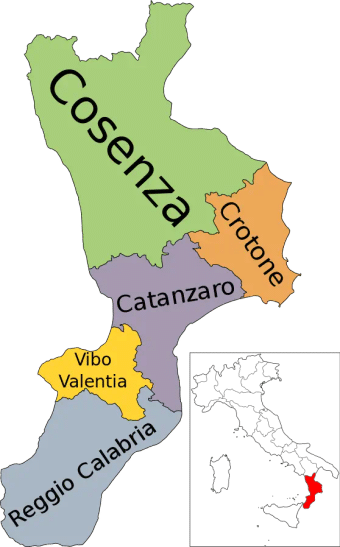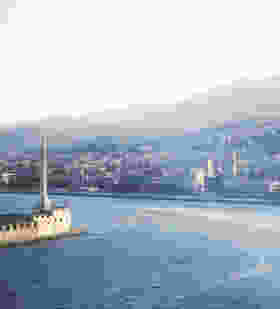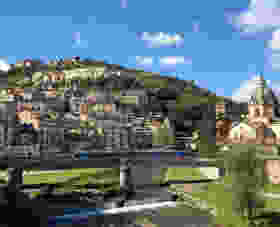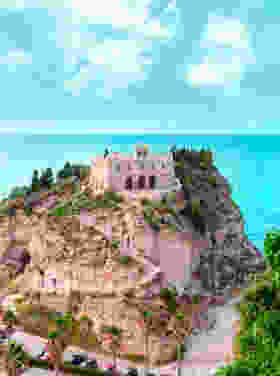Overview

The city of Reggio Calabria, with a population of approximately 181,082 residents, is located in the southern region of Calabria.
Reggio Calabria is situated on the coast of the Ionian Sea and offers stunning views of the Strait of Messina, which separates Italy from Sicily.
The city is known for its beautiful seaside promenade, the Lungomare Falcomatà, and its impressive collection of ancient Greek artifacts at the National Archaeological Museum of Magna Grecia.
Visitors can explore the historic center, visit the Cathedral of Reggio Calabria, and enjoy the local cuisine, which includes traditional Calabrian dishes such as 'nduja and swordfish.
The larger Reggio Calabria metropolitan area comprises 97 towns (comuni) and covers an area of 3.184 km2.
The population density is 171 inhabitants per km2, making it somewhat densely populated.
The male to female ratio is 1.00:1.06.
Reggio Calabria[dead link] is a city in Calabria on the toe of Italy.
It's a ferry port for the short crossing to Messina in Sicily. It's of great antiquity, being part of the Hellenistic region of Magna Grecia, but there's little of that to see nowadays.
The city has suffered repeated earthquakes, and was pulverised by the terrible quake and tsunami of 1908.
Then came heavy Allied bombing in the Second World War. After the war the city suffered from economic slump and organised crime: 'Ndrangheta (organized crime) are believed still to exert a strong grip over local authority and businesses.
There are long-held plans to build a bridge from here to Sicily, but preparatory work was cancelled in 2013.
Search for:
Climate
The province of Reggio Calabria receives on average 255 hours of sunshine per month, or 8.5 hours of sunshine per day.NaN This is 8.05% more than the average for Italy and 0.95% more than the average for the region of Calabria.Throughout the year, it rains on average 7.75 days per month, which is an ordinary amount of precipitation for an Italian province.
During the autumn and winter season, there are usually 0.15 days per month with fog and 0 cold days per month with perceived temperatures below 3°C.
In the summer, there are on average 30.48 hot days per month with perceived temperatures above 30°C.
Weather Now
name Region.NameCost of Living
The average monthly income in Reggio Calabria is around 1253.76€, which is lower than the average for Italy.The estimated cost of living is around 1165.4€ per month for an individual or 1757.54€ per month for a family of 4.
The cost for renting a small apartment (2-3 bedrooms) in a main city area is around 516.7€ per month.
Overall, Reggio Calabria is affordable compared to other Italian provinces.
Living in Reggio Calabria is around 29.37% cheaper than the average of all Italian provinces.
Quality of Life
Healthcare
Healthcare in Reggio Calabria is below average.For every 10k inhabitants, there are around undefined pharmacies, 10.08 general practitioners and 26 specialized doctors per 10k inhabitants.
NaNAverage life expectancy in Reggio Calabria is very high at 82.1 years of age.
Education
Reggio Calabria has a lower-than-average percentage of high school graduates, around 52.2%; and a lower-than-average percentage of university graduates, around 17.1%.NaN The average number of completed years of schooling for people over 25 is 9.98, which is not far from the national average of 10.44.NaN There are 2 universities within the province.
Leisure
Reggio Calabria boasts a lively and energetic nightlife that reflects the region's vibrant culture.From bustling bars to energetic nightclubs, the city offers a range of venues to enjoy after dark.
Visitors can dance to the rhythm of local music, indulge in traditional Calabrian cuisine, and immerse themselves in the lively atmosphere.
Reggio Calabria's nightlife scene is known for its warmth, friendliness, and a touch of southern Italian charm.
Overall, Reggio Calabria has somewhat decent nightlife with 2.15 bars and 3.75 restaurants per 10k inhabitants.
Crime and Safety
The province of Reggio Calabria is overall moderately safe for expats.As of 2021, there are an average of 2597.9 reported crimes per 100k inhabitants.
This is 8.39% lower than the national average.
There have been around 0.3 deadly road accidents and 21.9 serious work-related injuries per 10k people in Reggio Calabria.
This is respectively 44.44% less driving accidents than average and -69.77% less work accidents than average.
Car theft is reportedly 116.89% higher than average with 152.97 cases per 100k inhabitants.
NaNReports of house thefts are 55.35% lower than average with 78.15 cases per 100k inhabitants.
NaNCases of robbery are uncommon with 78.15 reported cases per 100k inhabitants, about 44.08% less the national average.
Reggio Calabria has a mixed safety reputation. While the majority of tourists and residents enjoy their time in the city without any issues, it is important to be aware of certain safety concerns.
Reggio Calabria has experienced organized crime activities in the past, mainly associated with local mafia groups.
However, these incidents typically do not directly affect tourists or visitors.
Travelers should be cautious of pickpocketing and theft, particularly in crowded areas and tourist sites.
It is advisable to stay in well-populated areas and use reputable transportation.
Women should take extra precautions when traveling alone at night.
Reggio Calabria has a relatively low murder rate, and road accidents are infrequent.
However, it is important to follow traffic regulations and drive defensively.
Transport
Public transport in Reggio Calabria is lacking, and traffic is somewhat high.NaNThere are on average 0.66 active vehicles per person, against a national average of 0.66.
Around 0.05km per 10k inhabitants of the main city in Reggio Calabria consist of bicycle lanes.
This makes Reggio Calabria not very bike-friendly.
Local buses mostly all run to Piazza Garibaldi, in front of Stazione Centrale. The bus company is
Discover
Recommended Tours in Reggio Calabria
Provinces Nearby



